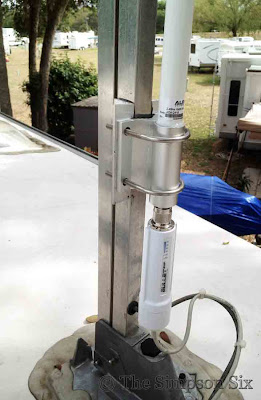On the road, we are constantly looking for an Internet connection so that we may update our apps and software, connect on Facebook and check email, and to write blog posts such as this one. A recent step that we have taken to help out with a more reliable connection and speed while not taxing our cellular data plan is to install a system to extend to existing wifi networks that we normally would not be able to access from our campsite. Thanks to our friends at Full Time Families for their initial write up on this system and to Steve for showing me how his setup works, I went ahead and purchased the hardware that I didn't have on hand and got to work. Below, you will find links to the products at Amazon. I already had the cabling and router on hand, but have included links to those as well.
The installation of the hardware was the easy part for me. I spent some time planning out how I wanted the wiring to be run down into the RV and then began with a Lowe's run to get the last few things that I needed. I planned on mounting the antenna to my TV antenna so that I could raise and lower it easily for travel.
 |
| Material to mount the antenna |
So my antenna is not going anywhere.
Once I attached the bracket to the antenna, I ran the cat 6 cabling to give the JB Weld time to cure. My TV antenna sits next to my front air conditioning unit, and I was able to find a path for the wire to come down into the RV there. I was unable to fish the wire through the ceiling, so I opted to use some wire mold to conceal and support the wire over to the router.
 |
| Clean and polished. |
The unit raises and lowers very easily and with little strain. I am happy with how clean the installation ended up being, albeit the fact that I cannot adjust the antenna up or down, but it is 14 feet off of the ground, so I think that reception will be alright.
There really aren't any setup instructions for the software on the bullet, but the company does offer a wiki and support forum for questions and troubleshooting. I was fortunate to have someone familiar with the interface that could field my questions. Being someone who is enough of a techie to be dangerous, I found it simple enough to use. Once the initial settings are taken care of, it is just a matter of logging into the bullet and selecting a wifi network to connect to. I have already noticed a huge difference in power and reception. I am able to 'see' 3 times as many networks as before. The down side is that even though I can 'see' some networks, they are not powerful enough to be able to communicate back and forth enough for me to use them.












No comments:
Post a Comment